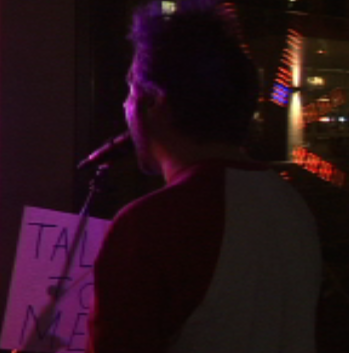


Swirler is an interactive, spatialized soundscape that is generated purely from the noises in the room. As sounds are made, they are chopped up into events which are then set off into a space with a life of their own, which then combine with the existing ambiance of the room. Each event is produces a distinct effect while changing the existing atmosphere. As there is more activity, the ambient drones are at first interspersed with percussive explosions of voice, noise, words, pitch, and feedback. Eventually continued activity completely replaces the original soundscape with a character of the incoming stream. The rhythm and spatialization are derived from activity in the room, each event launches with its own trajectory around the room, creating swarms of swirling sounds.

This piece is born the minute it first runs, grabbing key moments, then building up on top of each other, all controlled by the sound of the current moment. The events are spawned from a set of data, then released into the world, where they affect future events. The Swirler software currently works by clipping the incoming sound from a microphone whenever there is a percussive sound. These snippets are analyzed providing parameters such as loudness or noisiness. This data is used to create a sound event which has a predetermined life upon its release. Currently the controlled parameters of each sound event that are controlled are: size, speed of motion, and how many times the event is repeated.
November 17, 2006
At this show, Swirler was paired with Southstar, an interactive light sculpture, by Josh Goldberg and Glen Duncan. Also, Anton Marini's visualizations made using v001 are in the background of a couple of the videos.
August 31st, 2005
(thanks to Laura Garcia-Barrio for making the videos)
Swirler uses 6 speakers arranged in a circle around a microphone in the center. The setup is tailored to the physical surroundings where its installed, so the arrangement is not strict. The speakers are placed as inconspicuously as possible since this installation is meant to be as much in the realm of sound as possible.
Diagram of the layout of the equipment when set up in an empty room
Swirler can work in its own room or mixed in with other exhibits in another room. If its alone in a room, it becomes more of an instrument, waiting for input to react. If it is in a noisy environment, then it is constantly changing based on the sound coming it, yet still is interactive when people make sounds directed at it.
Swirler needs a computer running GNU/Linux, six or more speakers, a microphone, and a sound card with six or more output channels and one input channel. It takes 5 hours to set it up using my own equipment. It would take 6-10 hours using other equipment (including a computer running GNU/Linux), depending on how much software I had to install and configure. Swirler is written in Pd.
$Id: index.html,v 1.15 2010-03-10 21:59:50 hans Exp $